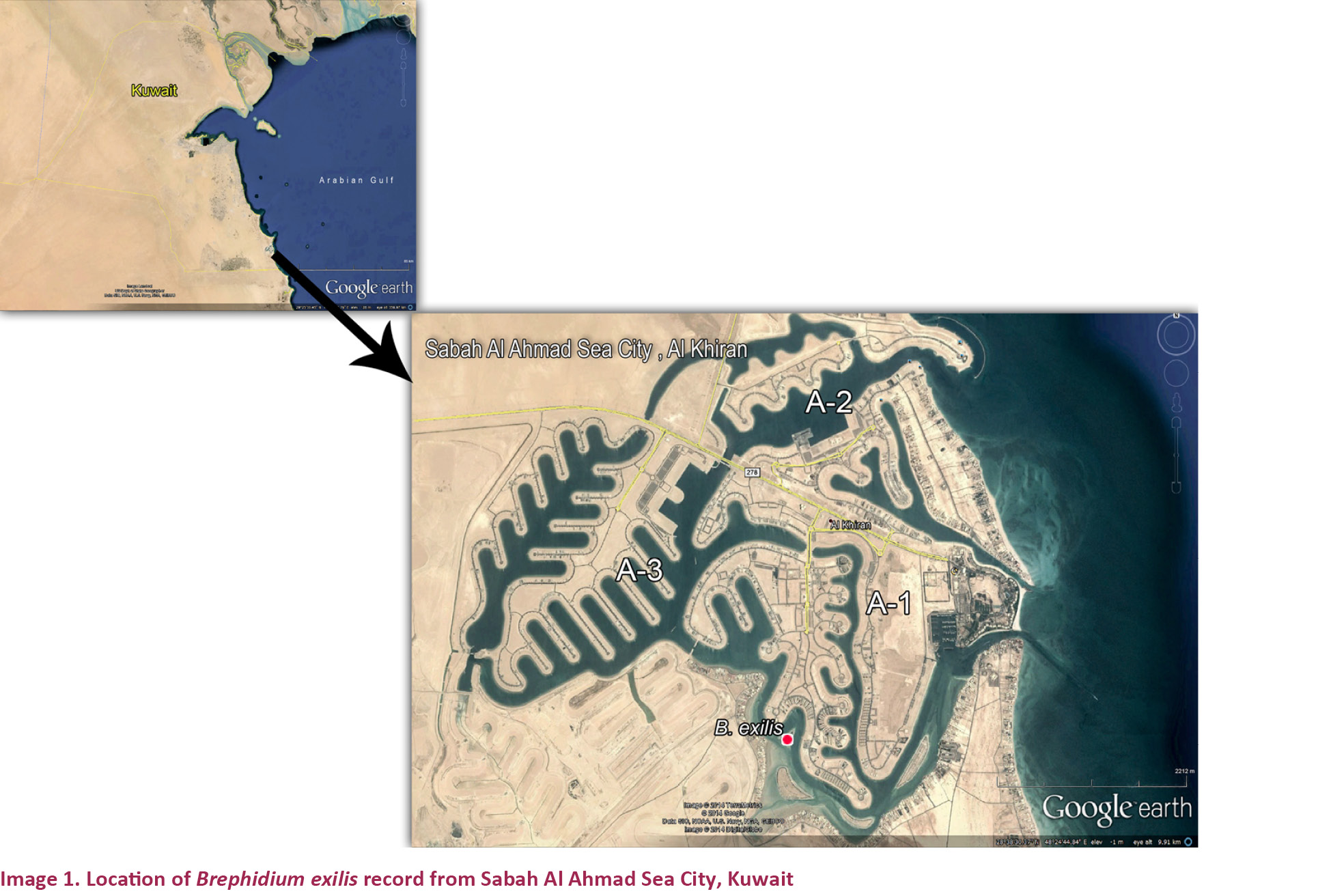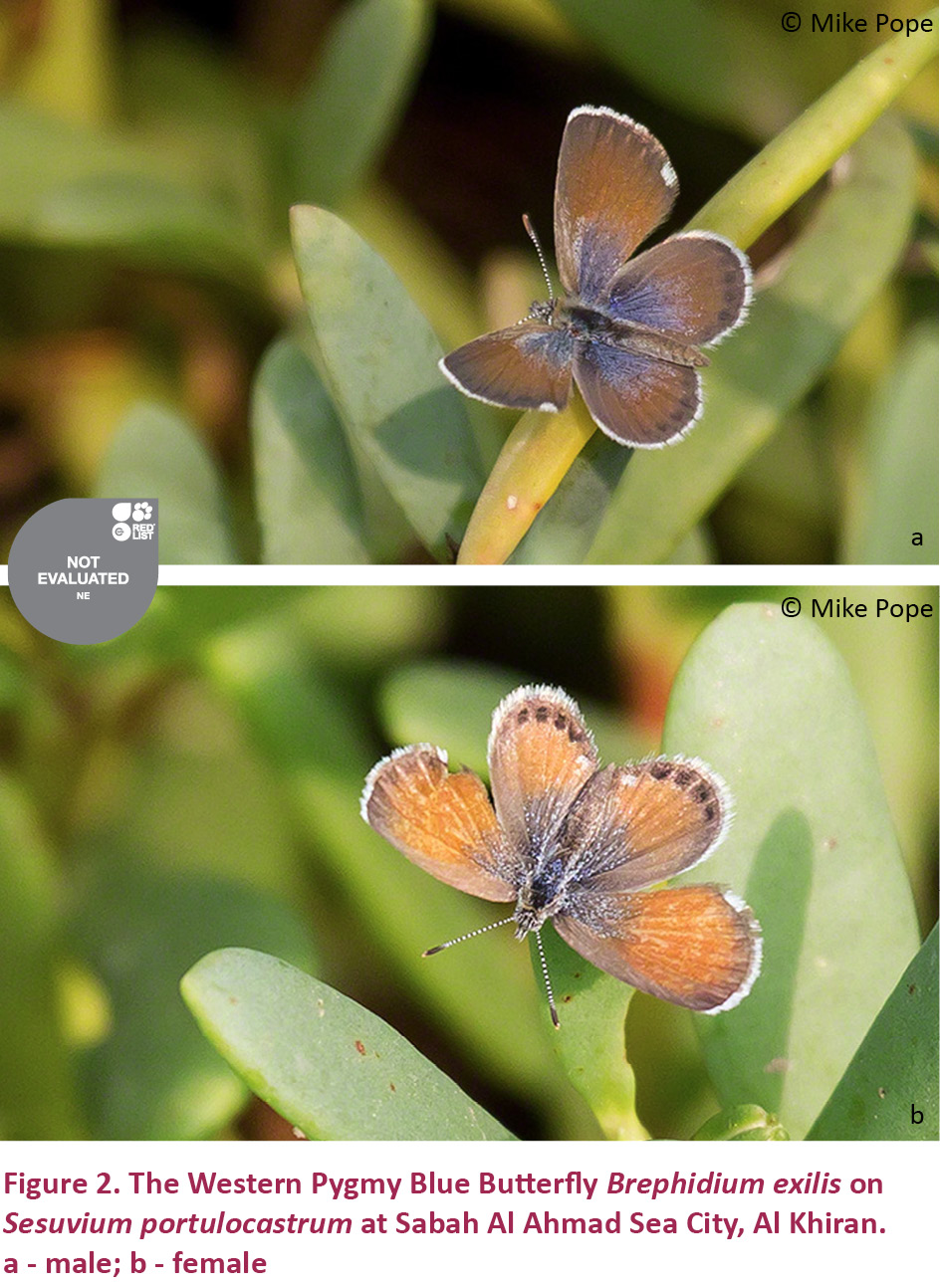Record of the Western Pygmy Blue Butterfly Brephidium exilis (Boisduval, 1852) (Lepidoptera: Lycaenidae) from Sabah Al Ahmad Sea City, Kuwait
Mike Pope 1 & Manickam Nithyanandan 2
1,2 Environmental Department, La’ Ala Al Kuwait Real Estate Company K.S.C. Sabah Al Ahmad Sea City Project, Souk Al Kuwait, 6th Floor, Office No. 613, P.O.Box 22964, Safat, Kuwait 13090
1 mikeinq8@gmail.com, 2 anand.ms@laalaalkuwait.com (corresponding author)
doi: http://dx.doi.org/10.11609/JoTT.o4055.6723-5 | ZooBank: urn:lsid:zoobank.org:pub:9DE78A3A-B5EC-4E73-912F-594BA3957597
Editor: Anonymity requested. Date of publication: 26 December 2014 (online & print)
Manuscript details: Ms # o4055 | Received 07 June 2014 | Final received 30 November 2014 | Finally accepted 02 December 2014
Citation: Pope, M. & M. Nithyanandan (2014). Record of the Western Pygmy Blue Butterfly Brephidium exilis (Boisduval, 1852) (Lepidoptera: Lycaenidae) from Sabah Al Ahmad Sea City, Kuwait. Journal of Threatened Taxa 6(14): 6723–6725; http://dx.doi.org/10.11609/JoTT.o4055.6723-5
Copyright: © Pope & Nithyanandan 2014. Creative Commons Attribution 4.0 International License. JoTT allows unrestricted use of this article in any medium, reproduction and distribution by providing adequate credit to the authors and the source of publication.
Funding: This study was funded by La’ Ala Al Kuwait Real Estate Co. K.S.C., Sabah Al Ahmad Sea City, Al Khiran, Kuwait.
Competing Interest: The authors declare no competing interests.
Acknowledgements: We sincerely thank Mr. Fawaz Khalid Al Marzouq, Chairman of La Ala’a Al Kuwait Real Estate Co. K.S.C. for the facilities provided and permission to publish this record. We also extend our thanks to Mr. Ian Williams, Project Director, Sabah Al Ahmad Sea City, Kuwait for his encouragement and to an anonymous reviewer for reviewing on earlier draft of the manuscript.

Sabah Al Ahmad Sea City (SAASC) is a coastal township development project on the southern coast of Kuwait, with a network of man-made lagoons, islands and beaches spreading over an area >100km2 (Jones & Nithyanandan 2012). This project involved modifying two tidal creeks: Khor Al Mufatah and Khor Al Ama, to build a series of tidal lagoons around which the urban development of Sabah Al Ahmad Sea City (SAASC) is being constructed in five phases (Image 1), of which three have been completed. Four artificial islands in phase A1 are intensively landscaped with halophytic plants such as Atriplex nummularia, Sesuvium portulocastrum and Avicennia marina.

Dedicated avian surveys have been conducted in SAASC since November 2012; during these surveys other fauna of interest such as invertebrates and reptiles were also recorded and photographed for identification. While carrying out a bird transect survey at Island 1, Phase A1 (Image 1) on 14 November 2013, MP noted numerous small delicate butterflies feeding off the flowers of the ground cover, Sea Purselane Sesuvium portulocastrum and on Oldman’s Salt Bush Atriplex nummularia. The same butterfly was again recorded on the islands of SAASC during subsequent surveys on 09 December 2013, 07 January, 08 February, 08 March, 12 April and 10 May 2014. Several digital photographs were taken using Canon DSLR and Canon 100–400 mm zoom lens. Larsen (1984) was referred to for identification, but no similar species was depicted in the book.
The pictures were sent through email to Dr. Torben Larsen in Denmark for identification, and he confirmed the identity of the butterfly as the Western Pygmy Blue Brephidium exilis (Boisduval, 1852) (Lycaenidae) (Images 2a,b). Brephidium exilis is recorded from UAE, Saudi Arabia, Northern Oman (Pittaway et al. 2006) and recently from Qatar (Pittaway & Larsen pers. comm., 27 March 2014). However, this is the first confirmed record of B. exilis from Kuwait and denotes its range extension into the north-western Arabian Gulf.
Brephidium exilis is a North American species which is suspected to be introduced into the Arabian Gulf by US expatriates working in UAE, who possibly carried succulents with eggs deposited onto the leaves or from use of North American halophytes for land reclamation, fodder and landscaping (Pittaway et al. 2006). The pan-tropical succulent, Sesuvium portulocastrum has been extensively used throughout the Arabian peninsula in landscaping and land reclamation projects since its first introduction to Abu Dhabi in 1989 (Böer 2002). Ubiquitous presence of S. portulocastrum in the region, the occurrence of host plants such as Atriplex spp. (Salt Bushes), and similar arid climatic conditions comparable to its native distribution range in North America are the main reasons for the successful establishment of this butterfly in this region (Pittaway et al. 2006).

During 1980–90 (pre-Gulf war), 75 species of Lepidoptera were recorded from Kuwait, however from 1991–2008 (post-Gulf war period) it declined to 68 species (Al-Houty 2009) and B. exilis was not recorded or known to occur in Kuwait. More detailed surveys have to be conducted to understand the species diversity and occurrence of any other exotic species. The present record indicates that B. exilis has established itself in the Arabian peninsula on exotic as well as native host plants since its probable introduction in the late 1990s (Gillett 1999), and there is a very real possibility that it will spread further within the region. Further investigation to estimate population characteristics and extent of distribution is necessary to understand possible impacts on native species.
References
Al-Houty, W. (2009). Insect biodiversity in Kuwait. International Journal of Biodiversity and Conservation 1: 251–257; http://dx.doi.org/10.5897/IJBC
Boer, B. (2002). Halophyte research: UNESCO supports halophyte research and development in Arabia. Biosalinity News 3: 6–7.
Gillett, P.M. (1999). Preliminary notes on some newly recorded butterflies from UAE and adjacent part of northern Oman. Tribulus 9.1: 22–23.
Larsen, T.B. (1984). Butterflies of Saudi Arabia and Its Neighbours. Transworld Arabian Library Riyadh, Stacey International London, 160pp.
Jones, D.A & M. Nithyanandan (2012). Recruitment of marine biota onto hard and soft artificially created subtidal habitats in Sabah Al-Ahmad Sea City, Kuwait. Marine Pollution Bulletin 72: 351–356; http://dx.doi.org/10.1016/j.marpolbul.2012.11.001
Pittaway, A. R., T.B. Larsen, A. Legrain, J. Majer, Z. Weidenhoffer & M. Gillet (2006). The establishment of an American butterfly in the Arabian Gulf: Brephidium exilis (Boisduval, 1852) (Lepidoptera: Lycaenidae). Nota Lepidopterologica 29: 3–14.